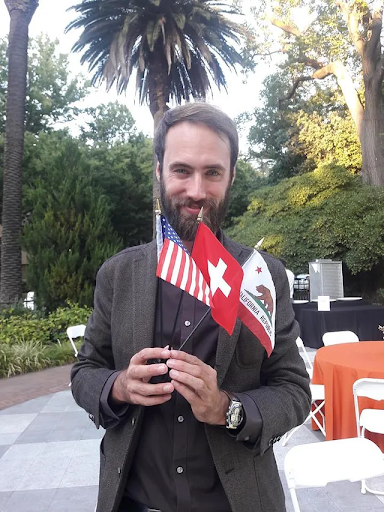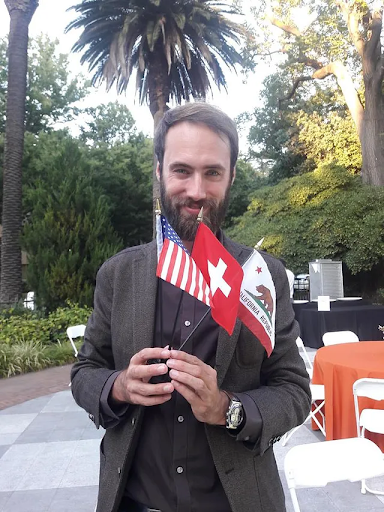As we explore a connected life, our society is still trying to comprehend how digital technology plays a role in creating life-changing and life-saving solutions that would not have been possible even 5-10 years ago. What is the role of entrepreneurs in creating technology that can solve some of the hardest problems in the world, such as humanitarian law and policy, or environmental impact?
With the incredible advances in connected technologies built on systems like the blockchain, digitalization has become a priority not only in the tech sector but also for organizations providing solutions for uses with extremely high stakes, such as humanitarian relief in conflict areas.
A colleague of mine, Yannick Heiniger, is currently working as a Senior Technology Diplomacy and Cyber Advisor for the Swiss foreign ministry in San Francisco. Yes, Silicon Valley’s tech companies have become so important that countries send diplomats to the Bay Area. Denmark started the trend by appointing a “Tech Ambassador” and Switzerland’s consul general in San Francisco also has the rank of an ambassador. Why? Because in today’s connected life, world politics is shaping Tech and Tech is shaping politics.
Yannick is one of the few professionals with experience in tech diplomacy. One of his prior jobs was with the International Committee of the Red Cross. He was working with digital technologies in conflict environments. You can read about his insights in this article for the International Review of the Red Cross. In this article, he discusses how digital technologies are being created to deliver humanitarian relief, and how the implementation of these technologies comes with significant opportunities and extreme risks. Some of these solutions include communications tools, service delivery, and crisis mapping that will empower those most vulnerable to seek help and collect resources to assist other communities. On the other hand, contributors of these technologies warn against inherent risks, such as data protection and privacy; when user data falls into the wrong hands, or if the information is disseminated in a misinformed way, it could put others in harm’s way, contrary to its original purposes. Using technologies to improve the lives of victims of wars and conflicts is a unique aspect of connected life – an extreme one perhaps but one where we can learn a lot for the more benign applications.

In a recent call with Yannick, he detailed just how great the stakes of his work can be.
“It is delicate working in places like South Sudan, Afghanistan, and other regions affected by war and chronic emergencies, where the gaps between the people and technology are massive,” said Yannick. “On the one hand, technology can save a tremendous amount of life, it could for example make major elections more efficient. But on the other hand, if the technology does not work people could die. It’s not like in the United States where, if your technology fails or you mess up your innovation project, you can just start over. Over there, error leads to loss of life. The challenge of innovating in humanitarian aid is that you must understand how to ensure that you can create safe environments for piloting, and ensure that everything you do will not create any additional harm, but rather reinforce the imagined situational improvement you are trying to pursue.”
Yannick, like me, is from Switzerland, which is known as the home of the Red Cross and the Geneva Conventions. Switzerland also has a long tradition as one of the biggest hubs for digital governance, with about 50% of Internet governance decisions taken in Geneva, where the world wide web was created. Yannick has worked as an innovation specialist at the intersection of these traditions, first at the Red Cross and for the last few years as the deputy and then acting CEO of Swissnex San Francisco, part of a global network connecting Switzerland and the world in education, research, and innovation. In both roles, he has observed the positive power of innovation and the potential benefits and risks of how tech firms could leverage knowledge and financial resources to influence technology diplomacy.
“What we see right now is that action and diplomacy are rapidly evolving, especially with advancements in AI and connected technologies, and each region is deploying these solutions in its own way. Therefore, collaboration between countries requires a level of knowledge of local politics, how they are using social media and gathering information, and other societal considerations. You cannot paint with a broad brush when deploying solutions, and each type of technology implemented, such as the blockchain or others, requires a great deal of context.”
Context is the operative word here when it comes to local politics. As we saw the global effects of how social media disinformation impacted the efficacy of healthcare and COVID vaccine dissemination, Yannick discussed how the spreading of information in vulnerable communities means accelerating solutions to pre-emptively combat issues, while also making risk-assessed solutions.
“We saw in places like Myanmar with the Rohingya genocide, a bad example of the side effects that can unintentionally be created by a company (in this case Facebook) creating a mobile communication solution with the best intentions: To provide a free information source accessible in one of the most fragile environments of the world. But one of the key challenges was that, when it came to combating the fake news spread about the Rohingya, practically nobody on Facebook had the capacity to speak the local language.
So disinformation was spreading at a faster rate than it could be addressed. What innovators can learn from this example is that it is essential to understand the ethics in technology as digital dilemmas,” said Yannick.
“At the end of the day, making innovation work in any company means making decisions. And there are many methodologies to choose from. The most important thing to remember is that no matter what technology you choose, you always have to come to the problem with a very clear idea of the problem before you even begin to think of the solution.”
This comes back to a topic I speak about very often in many of my classes: design thinking. One of the common things I frequently see in Silicon Valley is reverse engineering of the design thinking methodology. Many companies come up with a solution in search of a problem, rather than a problem in search of a solution. And with hot new technological advancements booming, such as the implementation of AI, it can be enticing to want to jump on the bandwagon. In Yannick’s line of work, he discourages reverse thinking and advocates for a more holistic approach: Technology has to solve people’s problems to be meaningful.
“Technology should be an afterthought. It’s so interesting how everyone is going for blockchain, or AI, or other solutions when half the world’s population doesn’t even have access to basic services. It can’t be just about how the solutions are deployed. First and foremost, the question should really be about understanding the context and side effects, and only then bringing the technology and seeing how it affects the first two or three dimensions. And we have to look at things holistically, and see where it will be implemented because every region will be so different.”
When asked about his advice for other innovation specialists looking to solve macro issues, his advice was, “Be patient. Don’t jump on choosing a technology or choosing a collaboration just because you want to prove a use case for your product. Understand the problem first, and don’t use design thinking methodologies to have end users reframing their problem so that it fits a pre-existing solution.”
I couldn’t agree more.
For more information on Yannick’s projects in digital diplomacy, please check out his LinkedIn.



Pingback: Gert’s Digigram Newsletter of May 2023! – Gert Christen.org
This is an excellent article, that highlights the need to think about technology as a set of tools, rather than the primary objective of our activities. What I wonder if whether the author has studied Systems Theory? I would assume they have, as their language choices and emphasis on patient observation of real world events seems to imply as much. Thank you for the information and perspective.
Thank you, Bret, for your valuable comment. I hope I have understood the basics of systems theory, although not to the extent an engineer would have studied it! I do believe in its validity and try to observe it in my work. I am very much guided by the principles of Design Thinking and convinced that we must use technologies for the benefit of everybody. And we haven’t done a very great job at that…. all the best, Gert